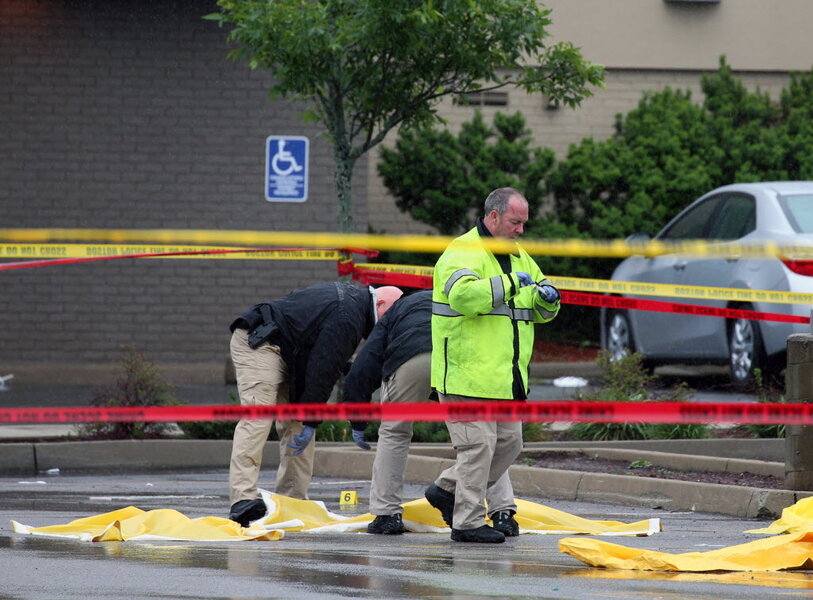After terror shooting, Boston police choose transparency over tradition
Loading...
As US police officers acknowledge feeling under siege by public unrest over deaths at the hands of police, the city of Boston, for the second time in just over a month, tried a new strategy – sharing grainy video of a police shooting with civic and religious leaders.
The new video involved a terrorism suspect, Usaama Rahim, who authorities say threatened retreating officers with a military-style knife on Tuesday before being fatally shot. The footage, community leaders said a day later, contradicted the contention by Mr. Rahim’s brother, an imam named Ibrahim Rahim, that he was shot in the back while talking to his father on the phone.
Darnell Williams, CEO of the Urban League of Eastern Massachusetts, declared after watching the video that Rahim “was not on a cellphone and was not shot in the back.”
Quickly releasing video to community leaders, acknowledges Daniel Conley, district attorney for Suffolk County in Massachusetts, goes against a long-held policing tradition in which investigative details are kept under wraps until a trial. The strategy stands in sharp contrast to how officers acted after last year’s shooting of Michael Brown in Ferguson, Mo. There, days after violent protests had already erupted, police revealed only piecemeal and contradictory information.
Boston's strategy is an attempt at transparency – to reach out to those who may have questions and concerns about what happened, and whose views can be influential in the community.
Mr. Conley called Wednesday’s meeting with community leaders “unprecedented,” and the strategy “a step forward” in police-community relations. Mr. Williams suggested it could become a national model for containing community rumors when citizens are shot by police under contested circumstances.
"There’s certainly a movement among progressive police departments to be more transparent when it comes to many activities and certainly use of force," says University of South Florida criminologist Lorie Fridell, who regularly conducts police trainings – including in Boston last week – on how to conduct fair and impartial policing. The police transparency movement, she says, comes "in the wake of events this past year, where every shooting is presumed by many to be a bad shooting, until the police prove otherwise."
While unprecedented in some ways, the Boston tactic is in fact part of a nascent effort among some police departments in the post-Ferguson era to show more transparency during investigations of controversial shootings. One example: In March, Michael Koval, the police chief in Madison, Wis., went within hours to visit the mother of an unarmed teenager, Tony Robinson, who was killed during an altercation with a police officer.
Mr. Koval released the name of the officer a day after Mr. Robinson's death. By contrast, in Ferguson it took nearly a week for police to release the name of the officer who shot Mr. Brown.
Political leaders also decried police shooting deaths in North Charleston, S.C., and Baltimore. In both cases, officers were charged with murder for killing black suspects.
It’s worth noting that in Ferguson, there was no video of the shooting of Brown. However, police instead released a video of him allegedly strong-arming a convenience-store clerk moments before the shooting. The police move to address Brown’s character only fueled anger on the streets.
In Boston, an earlier police shooting also resulted in a meeting with community leaders. Amid building concern in April, police shared video of the shooting of Angelo West, who was the driver of an SUV stopped by police. The video shows Mr. West shooting a Boston police officer in the face with a .357-caliber weapon before running away. He was quickly shot and killed by other officers on the scene. The wounded officer survived.
In the case of Tuesday’s shooting, police say Rahim was under 24-hour surveillance by members of a federal Joint Terrorism Task Force. According to Boston Police Commissioner William Evans, Rahim was approached on the street by several officers amid growing concern about what the man might do next.
The knife recovered from the incident looks very similar to ones seen in videos showing Islamic State militants beheading individuals. Authorities have said that they believe Rahim was planning to behead a police officer.
At the very least, Rahim had been under surveillance for spreading online propaganda for Islamic State, says Rep. Michael McCaul (R) of Texas, who chairs the House Homeland Security Committee.
Rahim was under suspicion for "communicating with and spreading ISIS propaganda online," according to Representative McCaul, speaking at a congressional hearing Wednesday morning. "These cases are a reminder of the dangers posed by individuals radicalized through social media.”
Not all community leaders at Wednesday’s meeting were convinced that the shooting was justified.
Imam Abdullah Farooq, who was at the meeting, called the video “inconclusive” and suggested that police “might have approached [Rahim] in a different way.” But he thanked Boston police officials for being transparent and said he would reserve judgment on whether police were in the right until after investigators complete their probe.








